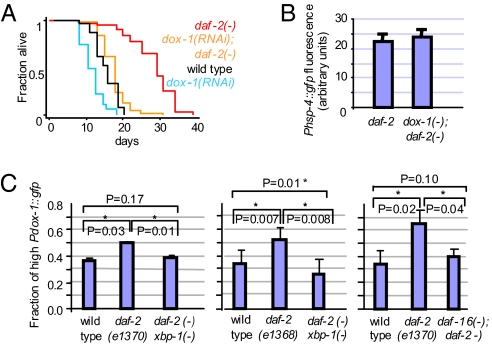Fig. 4.
dox-1 promotes longevity, but not ER stress resistance, in daf-2 mutants. (A) Reduction of dox-1 activity by RNAi shortened the lifespan of daf-2(mu150) mutants more than it shortened the lifespan of daf-2(+) animals. Animals were in a fer-15(b26); fem-1(hc17) background to prevent reproduction. Similar results were seen in daf-2(e1370) mutants (Table S1). (B) Reduction of dox-1 did not increase the set-point of the ire-1/xbp-1 branch of the UPR in daf-2 mutants. Bar graph showing the mean intensity of day-2 adults expressing a Phsp-4::gfp transgene. daf-2(e1370), n = 13, relative mean fluorescence intensity (m) = 21.9 ± 2.2; dox-1(RNAi); daf-2(e1370), n = 17, m = 23.3 ± 2.3, P = 0.677. See Fig. S4 for representative micrographs and wild-type data. (C) dox-1 expression was up-regulated in daf-2 mutants. Bar graph showing the fraction of animals expressing high levels of Pdox-1::gfp. Day-1 adults of each strain were classified as expressing high or low GFP levels (Fig. S4). The fraction of animals expressing high levels of Pdox-1::gfp was 1.35 fold higher in transgenic daf-2(e1370) mutants than in wild-type animals (P = 0.037), but was not significantly increased in daf-2(e1370) xbp-1(tm2457) double mutants. The fraction of animals expressing high levels of Pdox-1::gfp was 1.52 fold higher in transgenic daf-2(e1368) mutants than in wild-type animals (P = 0.007), but was not increased in daf-2(e1368) xbp-1(tm2457) double mutants. The fraction of animals expressing high levels of Pdox-1::gfp was higher by 1.8 fold in transgenic daf-2(e1370) mutants than in wild-type animals (P = 0.026), but was not significantly increased in daf-16(mu86); daf-2(e1370) double mutants. Error bars represent SEM of at least two independent trials. Asterisks mark Student t test values of P < 0.05.

